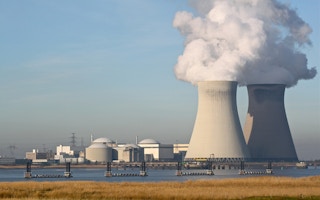There is enough uranium available on the planet to keep the world’s nuclear industry going for as long as it is needed. But it will grow steadily more expensive to extract, because the quality of the ore is getting poorer, according to new research.
Years of work in compiling information from around the world has led Gavin M. Mudd from Monash University in Clayton, Australia to believe that it is economic and political restraints that will kill off nuclear power and not any shortage of uranium, as some have claimed.
Writing in the journal Environmental Science & Technology that renewables do not have the disadvantages of nuclear power, which needs large uranium mines that are hard to rehabilitate and which generates waste that remains dangerous for more than 100,000 years.
In addition, research shows that renewable technologies are expanding very fast and could produce all the energy needs of advanced economies, phasing out both fossil fuels and nuclear.
Mudd, who is a lecturer in the department of civil engineering at Monash, has compiled decades of data on the availability and quality of uranium ore. He concludes that, while uranium is plentiful, mining the ore is very damaging to the environment and the landscape.
“
The future of nuclear power clearly remains contested and contentious — and therefore difficult to forecast accurately. While some optimists remain eternally hopeful, reality appears to be relegating nuclear power to the uneconomic category of history
Gavin M. Mudd, Monash University
It is expensive to rehabilitate former mines, not least because of the dangerous levels of radiation left behind. As a result many of the potential sources of uranium will not be exploited because of opposition from people who live in the area.
‘Too cheap to meter’
His paper examines the history of uranium mining and its wild fluctuations in price. These have little to do with supply, but rather with demand that is badly affected by nuclear accidents like Chernobyl and Fukushima, and by the political decisions by governments to embark on new nuclear building programmes, or to abandon them.
“Despite the utopian promise of electricity ‘too cheap to meter’, nuclear power remains a minor source of electricity worldwide”, Mudd writes. In 2010 it accounted for 5.65 per cent of total primary energy supply and was responsible for 12.87 per cent of global electricity supply. Both contributions have effectively been declining through the 2000s.
“Concerns about hazards and unfavourable economics have effectively slowed or stopped the growth of nuclear energy in many Western countries since the 1980s.”
The Fukushima accident in Japan has accelerated the trend away from nuclear power. The growth in projects in some countries, notably China, Russia and India, does not offset the fact that many more nuclear power stations will reach retirement age over the next 15-20 years than will be constructed.
Among the factors Mudd considered in the fluctuation of supply was the conversion of Russian and American nuclear weapons into power station fuel supplying 50 per cent of American needs since the mid-1990s, and 20 per cent of global uranium supply. This has not materially affected the long-term supply of uranium.
Mining blighted
Another issue that is more politically contentious is the high cost of rehabilitating mines, notably in Germany and the US. In many of the countries where uranium has been mined and no rehabilitation attempted, the prospect of further mining is blighted. Mudd gives the examples of Niger, Gabon, Argentina and Brazil, where there has been considerable public opposition to opening up fresh deposits as a result.
If these resources and other uranium deposits elsewhere in the world are to be exploited, Mudd argues, the issue of rehabilitating existing and future mines needs to be addressed.
“There is a critical need for a thorough and comprehensive review of the success (or otherwise) of global U mine rehabilitation efforts and programmes; such a review could help synthesise best practices and highlight common problems and possible solutions,” he says.
The paper also examines in detail the quality of the ore and the difficulty of extracting uranium from various rocks. Mudd concludes that as time passes the richer ores in the rocks that are easiest to extract are becoming scarce.
As a result, for each pound of uranium extracted more greenhouse gases are generated, adding to the CO2 emissions of nuclear power. However, he believes, in the overall comparisons of various energy systems the increase is only marginal.
“The future of nuclear power clearly remains contested and contentious — and therefore difficult to forecast accurately. While some optimists remain eternally hopeful, reality appears to be relegating nuclear power to the uneconomic category of history.
“Overall, there is a strong case for the abundance of already known U resources, whether currently reported as formal mineral resources or even more speculative U sources, to meet the foreseeable future of nuclear power. The actual U supply into the market is, effectively, more an economic and political issue than a resource constraint issue,” Mudd says.










